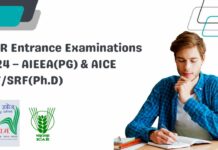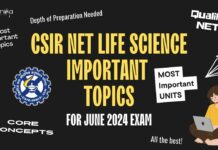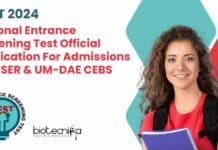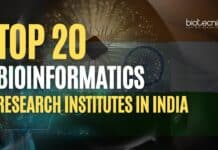Top 10 Type of Questions that comes in CSIR NET Life Science Exam
First, do you need to know what type of questions comes in the CSIR NET exam? The answer is – of course, yes. For example, in a Chess game, you need to know the game first to play it.
Some Benefits of Knowing the types of questions asked in the CSIR NET Exam –
- Helps you know the trends & patterns of questions asked
- Helps to Build your mental awareness & confidence
- Helps In Directed & Channelized Preparation – you will be able to relate to the type of questions asked from any UNIT; your preparation will be focused in that direction.
Let’s look at the Top 10 Questions that are often asked in the CSIR NET Life Science Exam.
Table of Contents
CSIR NET Question Type 1 : Mutational phenotype / Transplantation based questions
This category involves questions like – If you mutate a particular gene, an enzyme, a growth factor, or a hormone what will be the Phenotypic effect. Mostly UNIT 5 questions belong to this category. Also Transplantation based questions like – If you take this part and if you put it somewhere else then what will be the result? What will be the phenotype, phenotype effects of that?
While solving the above questions you need to keep the following things in mind:
- Understand what has been done
- Recollect what is the role of the gene or cell/region
- Think about the effect or its presence/absence
- Preparation tip: Make columns of gene/cell and functions
Question Sample 1: From CSIR NET June 2017 Exam
Antennapedia complex in Drosophila contains five genes, lab, Pb, dfd, SCR, and Antp and they express in parasegments 1 to 5, respectively in a non-overlapping manner. In the larva or in later stages of development, the region of Antp (Antennapedia) expression corresponds to a part of the second thoracic segment. A mutation in Antp is known to cause the transformation of the antenna to leg-like structures.
Below are certain statements made with respect to the functions of Antennapedia:
A. In the above described Antp mutation, the gene ectopically expresses in the head region
B. One of the functions of Antp is to repress genes that induce antenna development
C. Antp expresses in the thorax and forms a concentration gradient in the posterior-anterior direction, thus affecting head development
D. A homozygous recessive mutation of Antp is expected to transform the leg into the antenna in the second thoracic segment
Which combination of the above statements correctly describes the function of Antennapedia?
1. A, B, and C – Correct Answer
2. B and C
3. C and D
4. A, B, and D
Question Sample 2: From CSIR NET Nov 2020 Exam
Q. The hedgehog pathway is extremely important in vertebrate limb development, neural differentiation, and facial morphogenesis. In accordance with the above statement, what would happen in mice that are homozygous for a mutant allele of sonic hedgehog (shh)?
- Limbs would form normally but the mice would have facial abnormalities
- The midline of the face would be reduced and a single eye would form in the center of the forehead – Correct Answer
- Eyes would form normally but digits would be malformed
- Mutations of shh may activate tumor formation if Patched protein can inhibit the Smoothened protein
CAUTION: Pay attention to what type of mutation has been done. Whether loss or gain of function, dominant or recessive.
________________________________________
CSIR NET Question Type 2. Arranging/Ordering questions
In such types of questions, you need to rearrange or put in sequence – Any steps or any process in an increasing or decreasing order.
Points to keep in mind while solving such types of questions:
- Look at the points and try to put them in sequence
- Write the arranged sequence on paper
- Match with the correct option
Question Sample 1: CSIR Question Dec 2016
In photosynthetic electron transport, electrons travel through carriers organized in the “Zscheme”. The following are indicated as directions of electron flow:
- P680 -> PQA -> PQB-> Cytb6f -> Pheo -> PC -> P700
- P700 -> A0 -> A1 -> FeSx -> FeSA -> FeSB -> Fd
- P680 -> Pheo -> PQA -> PQB-> Cytb6f -> PC -> P700
- P700 -> A1 -> A0 -> FeSB -> FeSA -> FeSX -> Fd
Which of the following combinations is correct?
- A and B
- B and C – Correct Answer
- C and D
- A and D
CAUTION :
- Be careful of the order: increasing or decreasing
- Wrong orders can confuse you
________________________________________
CSIR NET Question Type 3. Numerical type questions
Straight numerical-based questions based on some concepts.
Points to keep in mind while solving such types of questions:
- Write down given things
- Apply the appropriate formula
- Do required unit conversions
- Calculate properly
- Convert answer into required unit or form
Even if you know the correct answer, things might go wrong because you are under tremendous pressure in the exam, and mistakes are bound to happen under pressure. So read & answer such questions very carefully, and do not misread anything.
Sample Question 1: CSIR NET Dec 2016
Q. The standard free energy change (AGo) per mole for the reaction A ^ B at 30oC in an open system is -1000 cal/mole. What is the approximate free energy change (AG) when the concentrations of A and B are 100 micromolar and 100 millimolar, respectively?
1. 3160 – Correct Answer
2. 316
3. 31610
4. – 3160
Sample Question 2
A segment of B-DNA encodes an enzyme of molecular mass 50 kD The estimated length of this segment in jam would be
A. 0.1547
B. 0.1547 xl0^-3
C. 0.4641 – Correct Answer
D. 0.4641 xl0^-3
CAUTION:
- Be very careful about unit conversions
- Be observation of the required unit and powers in answer
- Be patient and calm while calculating; no silly mistakes
- Solve such questions in the beginning
________________________________________
CSIR NET Question Type 4. Match the following questions
A very popular type of question asked in the CSIR NET Life Science Exam. Most of you will already know this.
Types of questions asked under this category:
- Gene /protein/enzyme – Function/composition/cofactor
- Growth factor/Hormones/Inhibitors/Antibiotics – Effect
- Organisms – Properties/Characteristics/Phylogeny
- Disease – Causative agents
- Scientists – Discovery
Sample Question 1: CSIR Question Dec 2017
Match the coenzymes in column I serving as transient carriers of specific atoms or functional groups in column II
1. A-(iv), B-(iii), C-(ii), D-(i)-Correct Answer
2. A-(iii), B-(iv), C-(i), D-(ii)
3. A-(i), B-(ii), C-(iii), D-(iv)
4. A-(ii), B-(i), C-(iv), D-(iii)
Sample Question 2: CSIR Question Dec 2016
Q. In animals, four separate families of cell-cell adhesion proteins are listed in Column A and their functional characteristics are given in Column B
Which one of the following is the correct combination?
1. a – (i), b – (ii), c – (iii), d – (iv)
2. a – (ii), b – (iii), c – (iv), d – (I)
3. a – (iii), b – (iv), c – (i), d – (ii)
4. a – (iv), b – (iii), c – (ii), d – (I)
Points to remember while solving match the following types of questions
- Try to match the easiest one/which you know
- Do not look at the entire table together, pick 1 point at a time and match against available options
- Mostly the topic of questions is well-known data
CAUTION:
- Avoid confusing match questions
- They are tempting questions, be careful of making a mistake
- Be careful in selecting the correct option
________________________________________
CSIR NET Question Type 5. Experimental result analysis/Technique application questions
In this type, CSIR may give you a certain experiment, and ask for the interpretation of that experiment – In a true or false format.
Points to remember while solving these types of questions
- The thorough concept behind the question topic
- Draw a mental image or rough diagram
- Draw a flowchart of the steps performed, an account of all that has been done, and in what sequence
- A clear picture of what the technique can do/cannot do
Sample Question 1: CSIR Question June 2019
Q. Based upon phenotypic observation, it was concluded that an unknown gene responsible for an agronomically important trait is present in a particular plant. In order to identify the gene, a researcher proposes to use the following strategies :
A. PCR amplification of the gene.
B. Map-based cloning of the gene.
C. Subtractive DNA hybridization
D. Genome sequencing
E. Develop molecular markers linked to the trait Which of the following option is most suitable for identifying the unknown gene?
Choose Your Answer:
1. A and C
2. B and E – Correct Answer
3. C only
4. A and D
Sample Question 2: CSIR Question June 2019
A neurophysiologist was interested in using the patch-clamp technique. The following statements are related to this technique:
A. Intracellular movement of ion channels.
B. Post-translational modification of the ion channel protein
C. Ligand controls the opening or closing of ion channels.
D. Changes in current flow in a single ion channel
Which one of the following combinations will be achievable using the patch-clamp technique?
Choose Your Answer:
1. A and B
2. B and C
3. C and D – Correct Answer
CAUTION:
- Don’t think stereotypically
- Give Attention to detail
____________________________________
CSIR NET Question Type 6. Questions involving Graph
These types of questions are very much common in the CSIR NET Exam. Any concept can be converted into a graphical format and questions can be asked from it.
How to handle such questions:
- Read the question carefully
- Read the Graph
- Make the correlation between the text and the graph
- Link the question with the underlying mechanism
Sample Question 1:
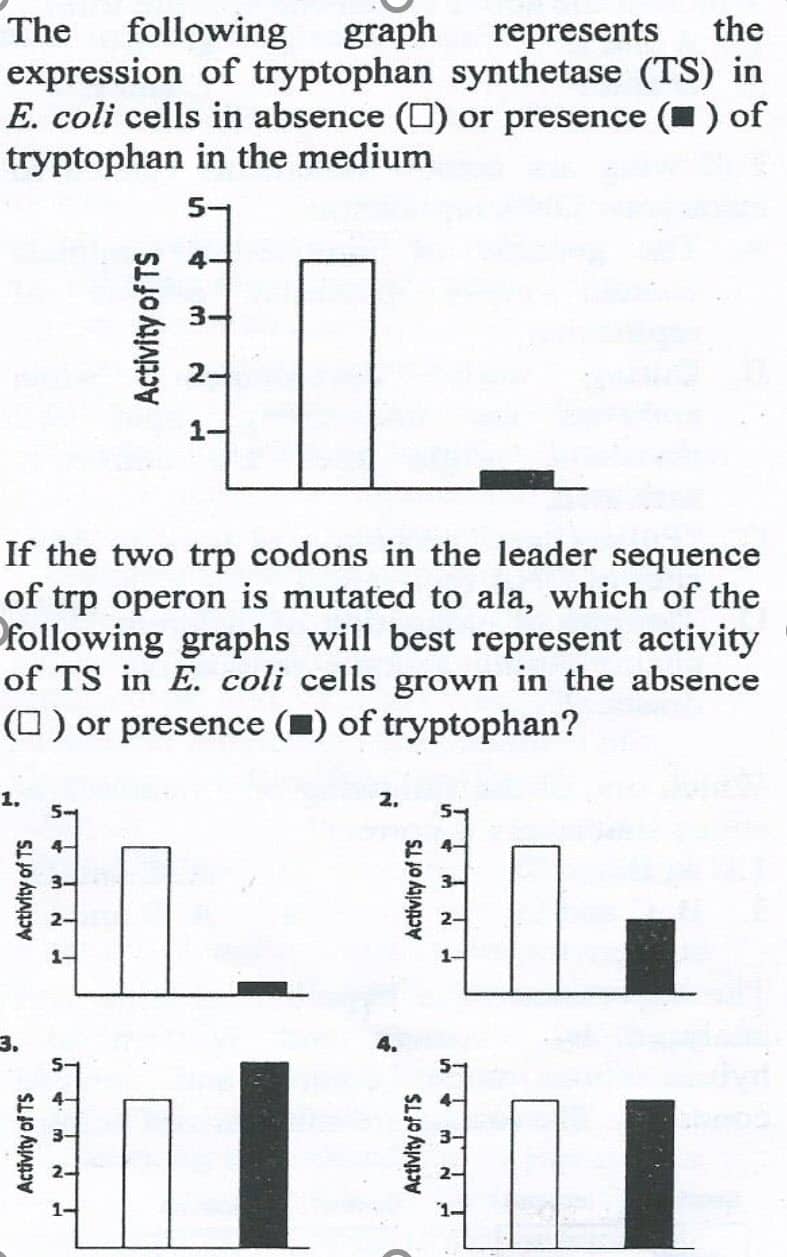
Sample Questions 2:
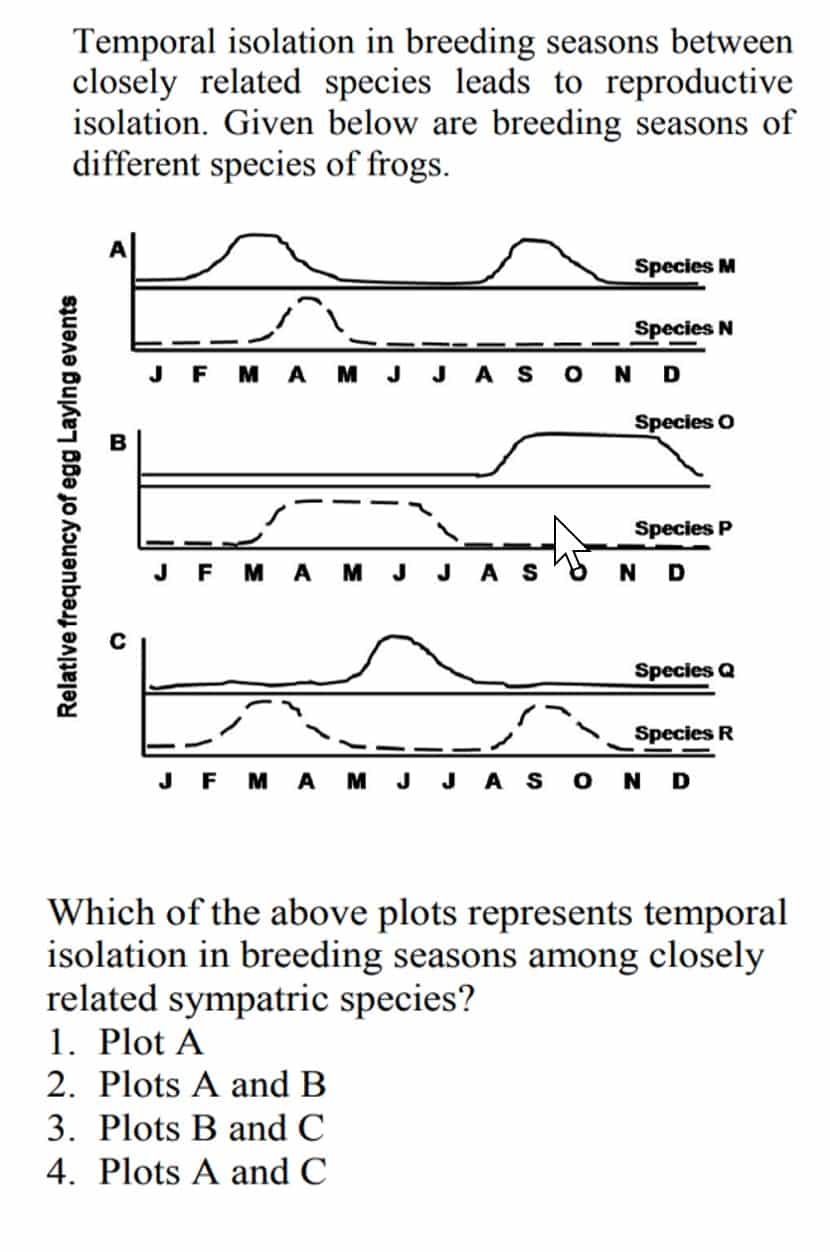
___________________________________________
CSIR NET Question Type 7. Questions based on pathways
Questions can come from the traditional pathways mentioned in the syllabus like the signal transduction pathway, Krebs cycle, Blood pathway, etc. But it is seen that CSIR NET loves to ask questions related to hypothetical pathways to judge your concepts and analytical skills.
How to handle such questions:
- Read the question carefully
- Read the pathway & understand it
- Correlation between the text and the pathway given
- Link the question with the underlying mechanism
Sample question 1:
Q. Consider the following hypothetical pathway:
H allele converts X substance to H substance
h allele cannot convert X to H substance and leads to phenotype ‘O’
A allele converts H substance leading to A phenotype
a allele cannot convert H substance
B allele converts H substance leading to B phenotype
b allele cannot convert H substance
When crossed with B phenotype, an individual with A phenotype has a progeny with O phenotype. Which one of the following crosses can lead to the above observation?
1. Aahhx BbHH
2. AaHh x BBHh
3. AaHh x BBHH – Correct Answer
4. AAHH x BbHh
Sample Question 2

____________________________________________
CSIR NET Question Type 8. Concept-Based Questions
In the CSIR NET syllabus, there are thousands of concepts learned & understand. Indirect or direct questions may be asked from any of those Concepts.
How To Handle Such Questions?
- After reading the question, identify the underlying concept
- There may be more than one concept from different units involved, so always correlate them.
Sample question 1

Sample Question 2

___________________________________________________________
CSIR NET Question Type 9. Formula Based questions
Includes questions where the answer can be found by applying direct formulas. Direct application of the formula, so if you understand the question & remember the formula, you will definitely have the correct answer.
How To Handle Such Questions:
- Identify the concept on which the question is based
- Substitute the values in formula
- Make sure to convert the units properly
Sample Question 1
Q. Red hair is a recessive trait in humans. In a randomly mating population in Hardy- Weinberg equilibrium, approximately 9% of individuals are red-haired. What is the frequency of heterozygotes?
1. 81%
2. 49%
3. 42% – Correct Answer
4. 18%
Sample Question 2
Q. The cell membrane of neurons maintains intracellular conditions that differ from those of the extracellular environment. Such differences in intra- and extracellular conditions are critical to the function of the nerve cell as the nerve cell membrane resembles a charged capacitor. Assuming the electric field (E) across a parallel-plate capacitor is uniform and if membrane thickness is 7 nm and the potential difference across the membrane is -60 m V, calculate the E of the membrane
1.6 x 105 V m-1
2.7 x 105 V m-1
3.8.6 x 106 V m-1 – Correct Answer
4.6.6 x 106 V m-1
Sample Question 3
Q. What is the generation time of a bacterial population that increases from 10,000 cells to 10,000,000 cells in four hours of growth?
1.10 mins
2.24 mins – Correct Answer
3.50 mins
4.62 mins
________________________________________
CSIR NET Question Type 10. Correct/ Incorrect Type of Questions
As the name suggests, questions can come where out of 4 options you need to answer which is correct or which is incorrect. In general, such questions are often found in PART B of the CSIR NET question paper. If such a question comes in PART C, it will be framed like selecting from a group of true or false statements per the question. This question is becoming more common in the CSIR NET exam.
How to handle such questions?
- Read – Read the question properly. Make sure what is asked in the question.
- Find – Read all the options and find & decide the most appropriate answer
- Alternate Way – By gradual elimination of the inappropriate options.
Sample Question 1
Q. The extracellular matrix (ECM) is a complex combination of secreted proteins that are involved in holding cells and tissues together. The components of ECM form a network by binding to each other and communicating with cells by binding to adhesion receptors on the cell surface. ECM comprises mainly two classes of macromolecules, proteoglycans, and very high molecular weight large proteins. Which one of the following statements regarding ECM constituents is INCORRECT?
- Proteoglycans are a subset of secreted or cell surface-attached glycoproteins containing covalently linked specialized polysaccharide chains called glycosaminoglycans (GAGs)
- GAGS are long branched polymers of specific repeating disaccharides of sialic acid and glucose or galactose. – Correct Answer
- Major types of GAGs present in ECM are heparan sulfate, chondroitin sulfate, dermatan sulfate, keratan sulfate, and hyaluronan.
- Major types of large proteins present in ECM are collagen, laminin, elastin, and fibronectin.
Sample Question 2:
Q. The different waves of a normal electrocardiogram (ECG) of a human subject are shown below:
The relationship of the events of the cardiac cycle to these ECG waves is proposed in the following statements.
A. The P wave occurs due to the depolarization of atria
B. The atrial repolarization is responsible for the T wave
C. The QRS complex occurs during ventricular depolarization
D. Q – T interval indicates plateau portion of auricular action potential
Select the combination with INCORRECT statements from the following options.
1. A and B
2. B and C
3. C and D
4. B and D – Correct Answer
_______________________________________
Tips and tricks on how to select easy questions to save time during the exam
- Direct knowledge questions – questions based on direct concepts
- Go for More of Match the following and graph/diagram-based questions
- Choose to answer questions with Easy option combinations; sometimes it’s very trick you may attract negative marking
- Opt for Shorter Introduction Part C questions
Tips & Tricks To Save Time during The exam.
- Do not randomly visit questions; proceed systematically.
- Sectional time limits – E.g., for Part A, keep 20 mins; for part B – 40 mins, and so on.
- Keep an eye on the options
- don’t get stuck in solving a single question for a longer time, don’t get married to a question – if you are not able to solve it – Move on
- You must know Calculation Short Cuts
Hope this will help you greatly in your CSIR NET life science exam preparation. Let us know in the comment section what kind of more such articles on CSIR NET you would like to read in the future.
If you want to download the PDFs of the types of CSIR NET questions asked and + Video with an explanation, then fill up the form below:
Download Lecture Video + PDF Here
or Fill Up The Form Below:
IS CSIR NET Exam Tough To Crack ? Mathematical Proof































